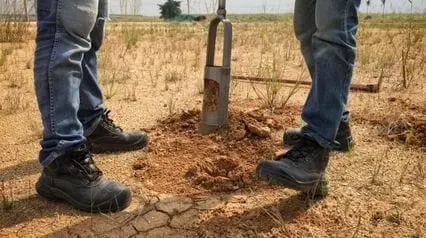What is Soil Boring?
Soil boring is the process of drilling a hole in the ground to collect samples of soil and bedrock. It is used to determine the soil’s physical and chemical properties and assess the suitability of the site for various engineering projects.
Soil boring is also used to install monitoring wells, measure the groundwater level, and collect samples of groundwater. Drilling rigs, hollow-stem augers, and core samples are some of the equipment used in soil boring.
Why is it Important?
Soil boring is a vitally important activity for construction projects. It may not seem exciting, but the process of drilling into the ground to collect samples of soil helps engineers and construction managers understand the composition of the Earth’s surface. This information is then used to help plan things such as building foundations, tunnels, and other structures.
Soil boring is an important process as it is used to investigate the subsurface conditions of the land, determine how suitable the soil is for construction, and assess the risks of landslides and other geologic hazards.
Is it Required in the Construction Process?
Construction managers typically oversee projects from start to finish, ensuring that they are completed on time, within budget, and to the specifications set forth by the client. Part of the construction process is boring soil to test its composition and strength. This is done in order to determine the best course of action for building on the land.
Soil boring is a necessary part of the construction process, and it is important to consult a professional before beginning any project. With the right planning and execution, soil boring can be a quick and easy process that yields valuable information about the land.
Difference Between Soil Boring and Sampling
Most people think that soil boring and sampling are the same thing. However, there is a big difference between the two. Soil boring is the process of drilling a hole into the ground in order to take a sample of the soil. This sample is then used to test the soil for various properties, such as texture, porosity, and more.
Sampling, on the other hand, is the process of taking a small sample of soil from the surface of the ground. This sample is not as representative of the overall soil as a boring sample, but it is still useful for testing certain properties.
Soil boring and sampling are both important methods for understanding the subsurface. Each has its own strengths and weaknesses, and each can provide valuable information about the subsurface conditions.
How is Soil Boring Done?
Have you ever wondered how soil borings are done? It’s actually a pretty fascinating process. Soil borings are done in order to collect samples of soil and rock from deep beneath the surface of the Earth. Here are the steps on how this process works:
- The site of drilling is selected and prepared for drilling. This could be a construction site, a location for environmental assessment, or any other situation where knowledge of the subsurface soil conditions is crucial.
- Choose the boring equipment that is appropriate for the type of soil and the desired sample to be collected.
- Start the soil boring process by drilling a hole into the ground and stop when desired depth is reached.
- Collect the soil samples, bring them to the surface, and put them in metal tubes or other containers to avoid contamination.
- Perform soil boring tests to the samples ato determine the strength and stability of the soil and rock.
Soil borings are an important part of construction projects, as they help ensure that buildings are safe and stable.
Digitize the way you Work
Empower your team with SafetyCulture to perform checks, train staff, report issues, and automate tasks with our digital platform.
Get Started for FreeApplications
Soil boring can be applied to a number of testing and sampling methods regarding soil classification. It can be applied to:
- Conducting feasibility studies involved in constructing dams, sewage disposal and irrigation projects
- Constructing natural gas pipelines and mining shafts
- Determining the boundaries between soil groups (geo-testing), which requires a number of vertical samples taken by soil borings at close intervals
- Analyzing the stresses exerted on foundations during construction and long-term settlement of buildings
- Starting any engineering project that involves tunnels, culverts, or deep excavations
- Verifying if there is any potentially contaminated soil and seasonal fluctuations in groundwater for safety
FAQs about Soil Boring
Depending on the type of soil properties, soil boring can go as deep as 30 meters in ordinary soil. It can also reach up to 3 meters into the sound rock if there is rock felt above the depth.
Soil boring usually takes about three weeks to complete. However, if there are more complex structures or designs needed to be done, it takes about a couple of months to finish.
A soil boring report is a document that details or includes information about the following:
- depth of land to bedrock;
- type of soil;
- the soil group it belongs;
- depth to seasonal wetness;
- depth of soil;
- soil color; and
- soil texture.
For structures that require a deep foundation, the needed number of borings should not be lower than two. It should be sufficient to discover the variations of soil layers in the site you’re planning to establish your building.



